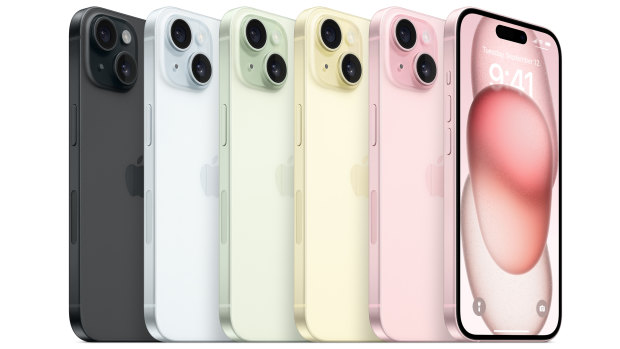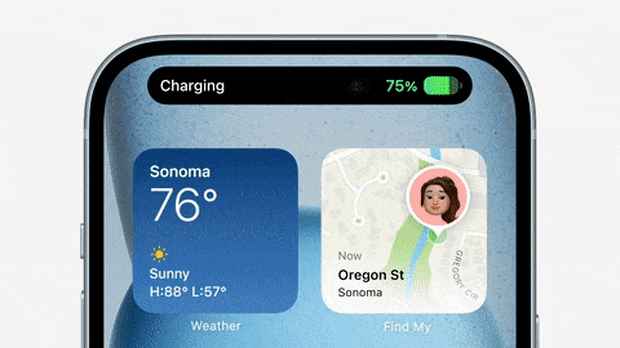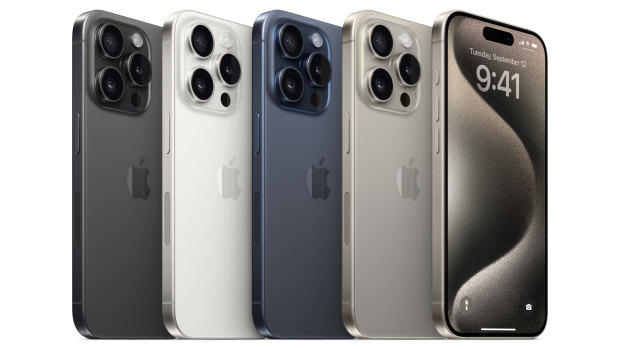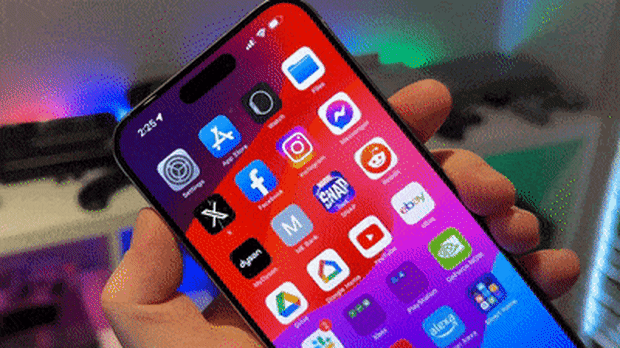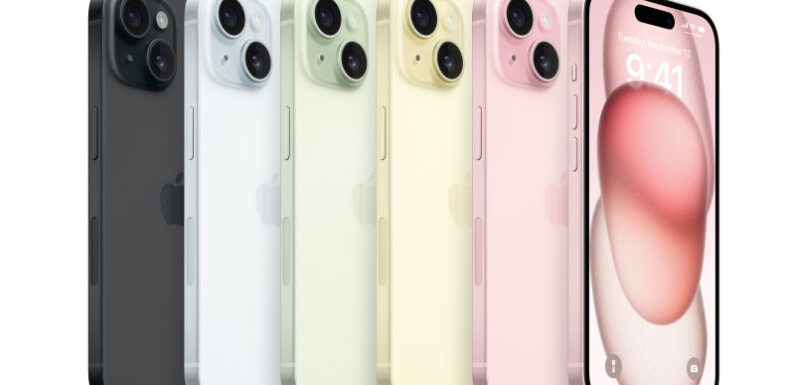
Save articles for later
Add articles to your saved list and come back to them any time.
For Apple’s 17th generation smartphones, a lack of surprises might not be all that surprising. But as far as modern releases go, the iPhone 15 lineup hitting shelves on Friday makes some significant advances in function, power, cameras and personalisation.
Of course, there’s never going to be a feature so mind-blowing that I’d recommend someone who bought a new iPhone last year do so again this week.
The standard iPhone this year gets pastel colours and a few new touches.
Apple has settled into a rhythm of bringing forward each generation’s strengths to the next and remixing them with a small handful of new ideas and improvements.
The main question for people considering the new phone – whether because their current model is getting old or because their contract is up – is whether the 15 do enough to justify the extra cost over the very solid 14 or 13.
Fresh finishes, new cameras
The iPhone 15 (and 15 Plus, which is functionally the same device, but with a bigger screen), borrows a bit from last year’s Pro phones. That includes the frosted glass back and powerful A16 chip, but most notably the “dynamic island”, a pair of display cutouts at the top of the screen that serve as a spot for notifications and a home for the selfie camera and Face ID.
Widgets for ongoing calls or media playback go here, as well as small versions of the home screen live activities, which keep track of things like food deliveries or sports scores. New apps are adding live activities all the time and they can be really handy — most recently, I saw one from an airline that would show your seat number, boarding updates and time remaining in flight — so it’s great to have the island now on standard iPhones.
Unfortunately, while the standard phone also has the brighter screen of last year’s Pro, it does not have the always-on display. This makes live activities a little less useful, since you have to prod your screen to check them.
The dynamic island is no longer a Pro-only feature.
The camera experience has changed somewhat across the board, despite each phone packing the same number of cameras as last year. The standard models have graduated to a much larger sensor on the main shooter, meaning in the camera app you can switch to a 2x mode that’s really just a crop of the 1x, but performs for all intents and purposes like a telephoto.
It delivers very crisp shots and is perfect for portrait mode, which now kicks in automatically any time a person or pet is detected. You can open such pictures in Photos to add the blur or even change the focal point.
The macro photography on iPhone 15 Pro is by far the best that Apple has ever had.Credit: Tim Biggs
The Pro has seven distinct views that Apple likens to different professional lenses. The macro lens kicks in automatically at close range and is amazingly improved from last year, able to render the pollen in flowers or the tiny hairs on a bug. Then there’s the ultrawide and three different options for standard shots depending on how close you like to be (24 millimetre, 28 millimetre or 35 millimetre), a 2x zoom like the standard phone, and a proper optical zoom at 3x on the Pro and 5x on the larger Pro Max.
It sounds like a lot, but it is streamlined and I appreciate being able to save 35 millimetre (or around 1.5x) as my default shot, so I don’t have to zoom in a little every time, and the stabilisation on the 5x for both photos and video is extremely impressive.
Ready for action (button)
Looking at the standard phone and the Pro side-by-side, it’s easy to spot which is which, and not just because of the always-on display and number of cameras. The standard has a matte aluminium frame that mimics the texture of its back glass for a nice cohesive feel, while the Pro has a brushed titanium frame and smoother glass for a decidedly aerospace vibe. The Pro also has a 120Hz refresh screen, making animation much smoother. Compared to the 14 Pro, this year’s fancy model is noticeably lighter, not-so-noticeably skinnier and has slightly thinner screen borders, which altogether works to widen the gap in premium look and feel between the least and most expensive models.
The iPhone 15 Pro’s titanium frame makes for a brushed metal look and an overall lighter device.
But in practice, one of the biggest differences is one of the least visible: the little ovular button on the Pro supplanting the mechanical mute switch that’s been on iPhones since the very beginning. The so-called action button can still work like mute if you like, you just hold it for a second to switch between ring and silent. But if you don’t do that often, you might prefer to stick mute in the control centre and have the action button do something else entirely.
It can toggle a favourite focus mode, turn on the torch, activate any accessibility feature or run any Siri shortcut (which on my iPhone, means it can also become a “Hey Google” button). But the most fun options are the voice memo, which lets you pretend your iPhone is an old school tape recorder ready to take your notes even if the screen is locked, and the camera, which will launch your preferred shooting mode at any time. In camera mode, the action button even works as a shutter.
Together with some of the changes that are coming to all iPhones in iOS 17 — like being able to bump them together to share photos or contact details or begin SharePlay, new and more interactive widgets, or the tabletop-or-bedside-ready StandBy mode — the action button is part of a new wave of features that make Apple’s devices feel a lot more personalised, and I’d expect it to come to the standard models next year.
The action button is a lot more useful and adaptable than the old ringer switch.Credit: Tim Biggs
You, me and USB-C
And finally, the whole lineup has had a change that will affect all users – the move from Lightning to USB as the main port. The adoption of the universal standard over Apple’s proprietary plug is a positive thing overall, and gives the iPhone more utility while letting you keep fewer cables around, but it isn’t without its niggles.
Any random cable and power brick will probably charge the phone, but for maximum charging speed, you’ll need both to be rated for at least 30W, and it’s impossible to tell by just looking at the cable. As for data transfer, the standard iPhone 15 supports basic USB 2 speeds like previous iPhones, while the Pro fully embraces the USB-C standard with speeds roughly 20 times faster. Again, cables differ, and if in doubt you might have to buy a good one. The one Apple includes in the box is rated for 20W charging and USB 2 speeds.
In terms of connecting accessories via USB-C, I honestly had a much easier time than expected. A USB-C headset worked immediately, as did a 2.4GHz dongle for a set of wireless headphones. A GoPro connected fine and transferred videos back and forth. A Backbone game controller worked perfectly (though I did need to connect it to an Android phone to update it first). The iPhone also supplied power to connected devices, including other iPhones (if you connect two 15s, the one with the fuller battery charges the other).
I have a hub in my lounge that I use to connect laptops and PCs to my TV, headset, keyboard and mouse with one USB-C, and plugging in the iPhone mirrored the screen straight away. It’s not the best big screen experience, since the iPhone doesn’t change resolution or aspect ratio, and the mouse didn’t work, so you’d need to keep the iPhone close by for navigation. But if you did want to use it as TV media device, or a game console with a Bluetooth controller connected, it’s simple.
And speaking of gaming, the 15 Pro has had a massive overhaul of its graphics capabilities and now basically packs the power of a desktop machine. I was able to test a native iPhone port of Capcom’s Resident Evil Village, and it more or less performs as you’d expect to see on a powerful MacBook – a locked 30 frames per second at around a 720p resolution, impressive for such a small device. The A17 Pro chip in the device supports a lot of the same tech as the M2 for Macs, so I suspect with more time and development, we could see even more versions of games currently being released on PlayStation 5 and Xbox Series X on the iPhone, if developers care to do that.
Get news and reviews on technology, gadgets and gaming in our Technology newsletter every Friday. Sign up here.
Most Viewed in Technology
From our partners
Source: Read Full Article
